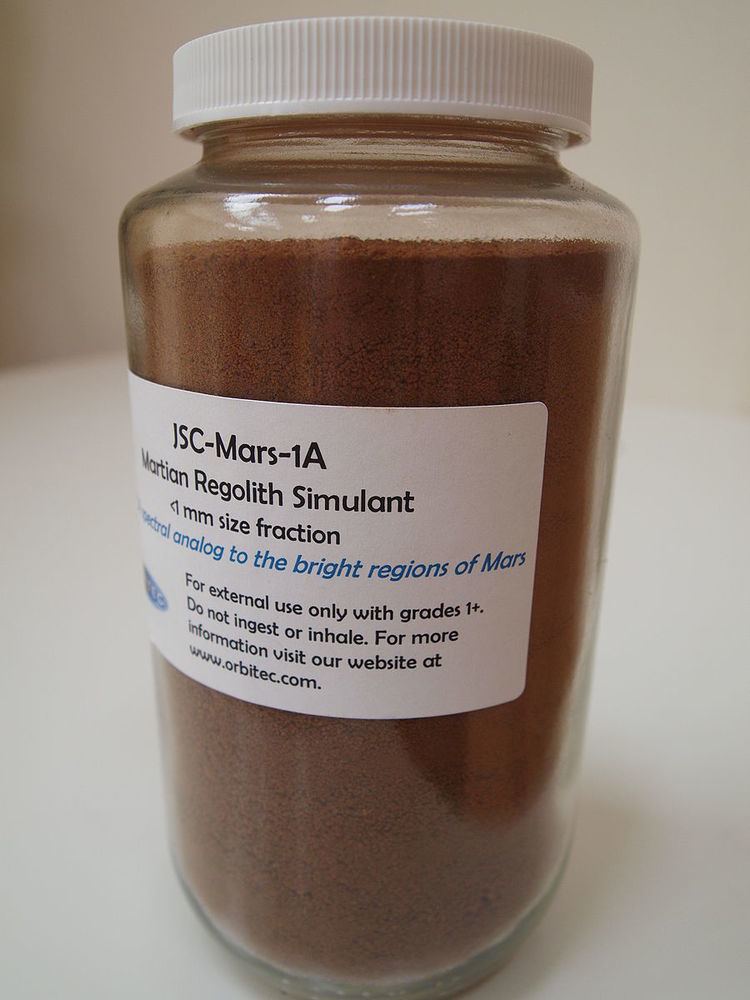 | ||
Martian regolith simulant (or Martian soil simulant) is a terrestrial material that is used to simulate the chemical and mechanical properties of Martian regolith for research, experiments and prototype testing of activities related to Martian regolith such as dust mitigation of transportation equipment, advanced life support systems and in-situ resource utilization.
Contents
JSC MARS-1
After the Viking landers and the Mars Pathfinder's rover landed on Mars, the onboard instruments were used to determine the properties of the Martian soil at the landing sites. The studies of the Martian soil properties led to the development of JSC MARS-1 Martian regolith simulant at NASA's Johnson Space Center in 1998. It contains palagonitic tephra with particle size fraction of less than 1 millimeter. The palagonitic tephra, which is glassy volcanic ash altered at low temperature, was mined from a quarry at the Pu'u Nene cinder cone. The studies of the cone, which is located between Mauna Loa and Mauna Kea in Hawaii, indicate that the tephra is a close analog to the bright regions of Mars.
JSC MARS-1A
As NASA returned to the Moon and Mars missions, there were needs for Lunar and Martian regolith simulants. NASA's Marshall Space Flight Center has contracted Orbital Technologies Corporation to supply 16 metric tons of improved lunar and Martian simulants since 2005. The company has also made an additional eight tons of Martian simulant available for other interested parties to purchase.
The simulant is made from palagonitic tephra at Pu’u Nene in Hawaii which is the same cinder cone that was used to create JSC MARS-1. The acquisition of the simulant is done by mining and sieving into sizes at the quarry. The particle sizes are separated into two categories, less than 1 millimeter and less than 5 millimeters. None of these particles are smaller than 13 µm. There is no additional milling or crushing to the materials.
After milling to reduce its particle size, JSC MARS-1A can geopolymerize in alkaline solutions forming a solid material. Tests show that the maximum compressive and flexural strength of the 'martian' geopolymer is comparable to that of common clay bricks.
MMS
MMS or Mojave Martian Simulant was developed in 2007 to address some issues with JSC MARS-1. While the JSC MARS-1 does simulate some Martian regolith properties well, it does not do well with others, including its hygroscopic qualities—it has undergone weathering that attracts water, making it more clay-like. MMS, however, is hygroscopically inert due to minimal weathering and the way it is crushed, which allows it to better simulate that feature of Martian regolith, among others. MMS can be found naturally as whole rocks in a volcanic formation near the town of Boron, California, in the western Mojave desert. The darker color basalt rocks can be crushed or sorted without creating weathering marks on them. After crushing, basalt sands can be processed and graded into particular sizes, MMS Coarse and MMS Fine. MMS Dust is smaller basalt particles which matches to the particle size distribution of Martian dust. A separate volcanic event created red-colored cinder which is mined and crushed to create MMS Cinder.
Health risks
Exposure to the Martian regolith simulant may pose some health risks due to the fine particles. JSC MARS-1A has slight hazard on inhalation and eye contact which may cause irritation to eyes and respiratory tract. There has been research into the toxicity of the simulants to the body cells. JSC MARS-1 is considered to have dose-dependent cytotoxicity. Therefore, it is recommended for precautions to minimize fine dust exposure in large-scale engineering applications.
